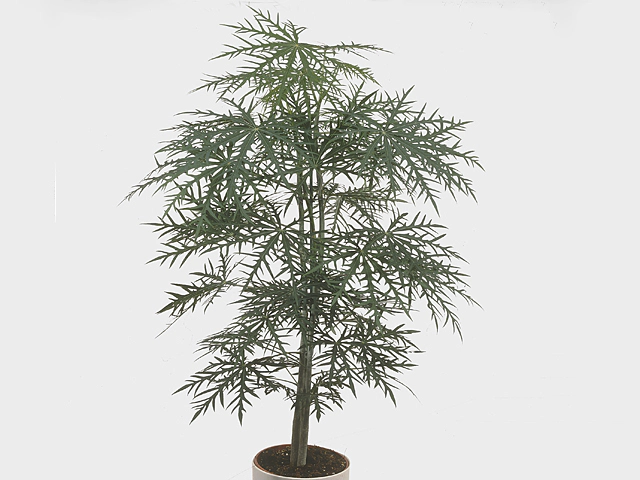Jatropha multifida

| Leaf base | Cordate (heart-shaped) |
| Leaf type | Foliage leaf |
| Plant height | 1,8 - 2 m |
| Inflorescence | Cyathium (spurges) |
| Structure (tissues) | Woody |
| Leaf size | 20 - 25 cm |
| Plant, growth type | Erect |
| Leaf colour, pattern | Bicolored |
Jatropha multifida: A Beautiful and Versatile Plant with Bicolored Foliage
Jatropha multifida, also known as the coral plant or physic nut, is a fascinating plant species that offers not only aesthetic appeal but also various practical uses. With its distinctive features and unique characteristics, this plant has gained popularity among gardening enthusiasts and horticulturists worldwide.
One of the key distinguishing features of Jatropha multifida is its cordate or heart-shaped leaf base. The leaves of this plant are foliage leaves, meaning they serve as the primary site of photosynthesis. With a size ranging from 20 to 25 cm, the leaves are relatively large, adding to the plant's overall visual appeal.
Growing to a height of 1.8 to 2 meters, Jatropha multifida exhibits an erect growth type. This means that the plant grows in an upright position, creating an imposing presence in gardens and landscapes. The plant's woody structure provides stability and resilience, making it suitable for various weather conditions.
In terms of inflorescence, Jatropha multifida produces cyathium, which are small, cup-shaped structures characteristic of spurges. These inflorescences are composed of tiny flowers surrounded by unique bracts that give them an exotic appearance. The plant's inflorescence is often brightly colored, adding a splash of vibrancy to any garden or outdoor space.
However, what truly sets Jatropha multifida apart is its bicolored foliage. The leaves feature a striking color pattern, with two distinct shades complementing each other. This bicolored effect creates a captivating visual display that captivates onlookers and adds a touch of elegance to any setting. The combination of colors can vary, with some plants exhibiting green and red hues, while others feature shades of green and yellow.
While Jatropha multifida is undoubtedly a beautiful plant, it also offers several practical uses. The seeds of this plant yield a type of oil known as Jatropha oil, which is used for various purposes. Jatropha oil has been used historically in traditional medicine and can also be converted into biodiesel, offering a renewable and environmentally-friendly alternative to fossil fuels.
Moreover, Jatropha multifida has been valued for its potential in landscaping and ornamental gardening. Its unique foliage coloration and distinctive growth habit make it a fantastic choice for creating eye-catching hedges, borders, or focal points in gardens. The plant's striking features can also be effectively used in floral arrangements and bouquet compositions, adding a touch of sophistication and drama.
In conclusion, Jatropha multifida is an extraordinary plant with an array of appealing attributes. From its cordate foliage leaves and erect growth type to its cyathium inflorescence and striking bicolored foliage, this plant stands out in any landscape or garden setting. Its practical uses, such as the production of Jatropha oil and its ornamental value, make it a versatile choice for gardening enthusiasts and horticulturists alike. Incorporating Jatropha multifida into outdoor spaces not only enhances their beauty but also contributes to sustainable practices.
Market availability index by month:
| Jan. | Feb. | Mar. | Apr. | May | Jun. | Jul. | Aug. | Sep. | Oct. | Nov. | Dec. |
|---|---|---|---|---|---|---|---|---|---|---|---|
| 3 | 3 | 3 | 3 | 3 | 3 | 3 | 4 | 3 | 3 | 3 | 3 |